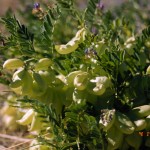Garboncillo, Rattleweed
Astragalus wootonii Sheldon
Description
Garboncillo is a much-branched annual in the Legume family. It has erect, hairy stems reaching 3 to 12 inches long.
The leaves are composed of nine to 19 leaflets, hairy beneath and smooth above. The flowers are pink or purplish to white, emerging from March to June.
The most conspicuous part of the plant is the fruit, a large, one-celled, inflated pod. When dry, the seeds in the pod break loose and rattle, giving it the name rattleweed.
This plant is poisonous to livestock and wildlife.
Habitat
In Texas, garboncillo is generally restricted to clay soils in the Trans-Pecos region. It is also common in southern New Mexico, eastern Arizona and northern Mexico. Garboncillo is most abundant in valleys receiving runoff water from the surrounding hills, as well as in bar ditches, along trails and around earthen tanks.
Toxic Agent
The toxic principle is an alkaloid called swainsonine. Horses are particularly susceptible to garboncillo, although cattle, sheep and goats are also poisoned. Consumption of about 90 percent of the animal's body weight in garboncillo is required before cattle show signs of poisoning. As much as 200 to 350 percent of their body weight of the plant, eaten over a period of several months, may be required to kill cattle, sheep and goats.
Horses eating about 30 percent of their body weight in the plant show clinical signs, and consumption of about 75 percent of their body weight may be fatal. Both dry and green garboncillo are toxic. Livestock readily eat the dead stems remaining after dieback at frost.
Signs of Livestock Ingestion
Clinical signs develop from the involvement of sensory and motor functions. In cattle, general signs include: Carrying the head a little lower than normal; A vacant stare; Trembling of the head; Difficulty eating and drinking; Abortion.
Swainsonine passes into the milk, possibly explaining the unthriftiness of some suckling calves. The period from onset of signs to death is much shorter in horses than cattle. The horse is listless, but on being stimulated becomes excessively excited, even to the point of inflicting a fatal injury to itself. Horses with chronic locoism rarely recover and are dangerous to ride because of unpredictable and permanent behavioral changes.
Management Strategies
Because garboncillo is an annual, mechanically removing the plant around tanks, along roadways and in other hazardous sites is often effective. Proper stocking rates and grazing management practices can help reduce consumption. Sound range management practices can prevent garboncillo poisoning. Livestock should receive proper supplementation of energy, protein, minerals and vitamins. For small problem areas, treat individual plants with a 2 percent solution of Grazon P+D® applied directly to the leaves of the plant. For a large area, aerial or ground broadcast applications of 0.94 pounds a.i./acre of Grazon P+D® (3 pints) have given good results.
Images
Plant Characteristics
Flower Color: Purple
Seed Type: Bean/Pod
Duration: Annual
Stem Texture: Hairless/Smooth
Growth Habit: Forbs/Broadleaf
Leaf Shape
 : Pinnately Compound
: Pinnately Compound
Season: Warm
Distribution
 : 09 - High Plains, 10 - Trans-Pecos
: 09 - High Plains, 10 - Trans-Pecos
Distributions
Distribution refers to the ecological region in Texas that a plant has been found. You can also view a clickable map.
Book: Brush and Weeds of Texas Rangelands (B-6208), Toxic Plants of Texas (B-6105)
Collection: Brush and Weeds, Toxics, Wild Flowers
Livestock Affected: Cattle, Goats, Horses, Sheep
Livestock Signs: Abortion, Birth Defects, Excitability, Incoordination, Loss Of Weight, Trembling, Unable To Eat/Drink, Unthrifty Offspring







